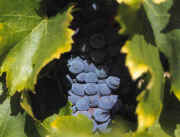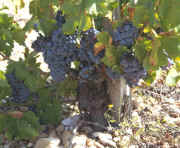
The Southern Rhone: Châteauneuf-du-Pape
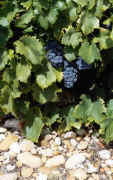
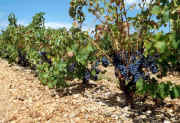 From Avignon, where we were staying,
Châteauneuf-du-Pape
is only a 20 minute drive. Even though this wasn't supposed to be a wine holiday, how
could we be so close to such a well known wine town and not visit it? Driving towards the
town through the vineyards our first impressions were that the Southern Rhone is actually
very different from the Northern Rhone: not only is the climate much warmer, but it also
has a more rustic feel. The vineyards themselves have a very different appearance, most
obviously the fact that they are flat. In addition, the gnarled old bush vines are not
trellised, but hug the pebble-strewn ground.
From Avignon, where we were staying,
Châteauneuf-du-Pape
is only a 20 minute drive. Even though this wasn't supposed to be a wine holiday, how
could we be so close to such a well known wine town and not visit it? Driving towards the
town through the vineyards our first impressions were that the Southern Rhone is actually
very different from the Northern Rhone: not only is the climate much warmer, but it also
has a more rustic feel. The vineyards themselves have a very different appearance, most
obviously the fact that they are flat. In addition, the gnarled old bush vines are not
trellised, but hug the pebble-strewn ground.
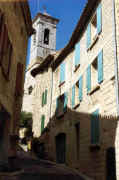
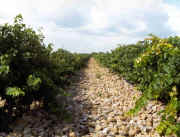 As a town,
Châteauneuf-du-Pape is exactly how you would expect it to be: with
its slightly-too-quaint stone buildings and narrow streets (left), it is a charming
and noticeably affluent place, almost completely given over to wine tourism. We began by
visiting the interesting wine museum at Pere Anselme (admission free), which is a good
place to start.
As a town,
Châteauneuf-du-Pape is exactly how you would expect it to be: with
its slightly-too-quaint stone buildings and narrow streets (left), it is a charming
and noticeably affluent place, almost completely given over to wine tourism. We began by
visiting the interesting wine museum at Pere Anselme (admission free), which is a good
place to start.
From the hilltop castle, as far as the eye can see the town is surrounded by sun-soaked vineyards. It is a nice place to visit, but not a particularly good place to stock up on wine: cheap Châteauneuf-du-Pape simply doesn't exist, and many of the good producers are located out of town and can only be visited by appointment. In the town itself, there is an awful lot of plonk being peddled for high prices, and of the 70 or so producers, only a handful make really compelling wines. We visited a couple of caves, and without naming any names, in one we were received rather disinterestedly, in the other positively rudely.
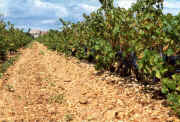 We spent some time cruising through the vineyards that
encircle the town. A characteristic feature of these is that the top layer of soil
consists of a layer of large, smooth pebbles. These apparently retain the daytime heat and
during the evening and night reflect it back to the vines, thus helping to ripen the
fruit. The grapes are certainly ripe enough for the wines to reach alcohol levels of 14 to
15%, but despite this, many examples I tasted had a thin, dilute texture. Red
Châteauneuf
can contain up to 15 grape varieties, among which the most important are Grenache, Syrah
and Mourvedre, so in the hands of a conscientious grower good results are achieved, but
the majority of wines you'll encounter here won't justify the high asking prices.
We spent some time cruising through the vineyards that
encircle the town. A characteristic feature of these is that the top layer of soil
consists of a layer of large, smooth pebbles. These apparently retain the daytime heat and
during the evening and night reflect it back to the vines, thus helping to ripen the
fruit. The grapes are certainly ripe enough for the wines to reach alcohol levels of 14 to
15%, but despite this, many examples I tasted had a thin, dilute texture. Red
Châteauneuf
can contain up to 15 grape varieties, among which the most important are Grenache, Syrah
and Mourvedre, so in the hands of a conscientious grower good results are achieved, but
the majority of wines you'll encounter here won't justify the high asking prices.
Despite the rather negative impression I've given here of the wines, we really did enjoy visiting the town and its surrounding vineyards, and all in all it is well worth seeing.
